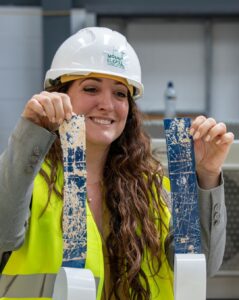When most people think about Passivhaus training, they picture architects sketching details and calculating U-values. But the truth is that Passive House education is just as relevant to project managers, engineers, contractors, developers, and sustainability leaders.
The reason is simple. Achieving Passivhaus performance is a team effort. It requires decisions and precision at every stage of a project, from early feasibility to on-site delivery. Without shared knowledge, even the best designs risk falling short.
Developers and Decision-Makers
For developers and investors, Passivhaus knowledge is no longer a “nice to have.” It is a way of safeguarding projects against regulatory risk and future retrofit costs. Training helps developers to:
- Understand how Passivhaus standards align with Ireland’s 2030 zero-emissions targets
- Gain clarity on the cost neutrality of large-scale schemes, as demonstrated by Shanganagh Castle and Pipers Square
- Build confidence when engaging with funders and ESG reporting frameworks
By engaging with Passive House training, developers can make informed strategic choices that protect both margins and reputations.
Engineers and Quantity Surveyors
Engineers and QS teams often act as the bridge between design ambition and construction reality. Training provides them with:
- The ability to identify performance risks such as overheating or thermal bridges
- Insight into how insulation, glazing, and airtightness contribute to certification
- A stronger foundation for balancing cost with long-term performance
With this knowledge, engineers and QS professionals can play a proactive role in ensuring buildings perform as promised, rather than as hoped.

Contractors and Site Teams
Passivhaus is ultimately delivered on site. No matter how precise the modelling, airtightness and thermal performance depend on workmanship. Training empowers contractors and tradespeople to:
- Execute airtightness details correctly and consistently
- Install materials in line with Passivhaus specifications
- Understand the importance of sequencing, quality checks, and sign-off testing
As Ireland’s demand for Passive House construction grows, trained contractors will be in highest demand.
Sustainability and ESG Leaders
For ESG directors and sustainability managers, training provides the technical insight needed to link building performance to corporate targets. It enables them to:
- Translate Passivhaus performance into measurable carbon reductions
- Provide credible data for ESG disclosures
- Strengthen governance and reduce the risk of “greenwashing” claims
In this way, training goes beyond technical detail and becomes a strategic ESG tool.
Building a Shared Language
Perhaps the greatest benefit of Passive House training is that it builds a common language across teams. When architects, engineers, developers, contractors, and sustainability leaders share the same understanding of airtightness, thermal bridging, and PHPP modelling, collaboration improves, and the margin for costly errors decreases.
At Mosart, we see this every day. Our Learning & Development programmes bring together professionals from across the industry, ensuring that everyone involved in a project is equipped with the skills to deliver.
Passivhaus training is not just for architects. It is for anyone who wants to future-proof their projects, their careers, and their organisations. By investing in education, professionals across the construction ecosystem can deliver buildings that are affordable to run, resilient against regulation, and healthier for residents.
If you want to learn more about how training can unlock opportunities for you and your organisation, explore our Learning & Development programmes.